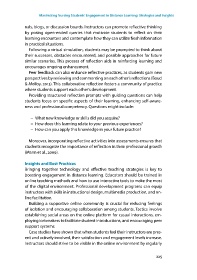Page 225 - International Perspectives on Effective Teaching and Learning in Digital Education
P. 225
Maximizing Nursing Students’ Engagement in Distance Learning: Strategies and Insights
nals, blogs, or discussion boards. Instructors can promote reflective thinking
by posing open-ended queries that motivate students to reflect on their
learning encounters and contemplate how they can utilize fresh information
in practical situations.
Following a virtual simulation, students may be prompted to think about
their successes, obstacles encountered, and possible approaches for future
similar scenarios. This process of reflection aids in reinforcing learning and
encourages ongoing enhancement.
Peer feedback can also enhance reflective practices, as students gain new
perspectives by reviewing and commenting on each other’s reflections (Boud
& Molloy, 13). This collaborative reflection fosters a community of practice
where students support each other’s development.
Providing structured reflection prompts with guiding questions can help
students focus on specific aspects of their learning, enhancing self-aware-
ness and professional competency. Questions might include:
− What new knowledge or skills did you acquire?
− How does this learning relate to your previous experiences?
− How can you apply this knowledge in your future practice?
Moreover, incorporating reflective activities into assessments ensures that
students recognize the importance of reflection in their professional growth
(Mann et al., 9).
Insights and Best Practices
Bringing together technology and effective teaching strategies is key to
boosting engagement in distance learning. Educators should be trained in
online teaching methods and how to use interactive tools to make the most
of the digital environment. Professional development programs can equip
instructors with skills in instructional design, multimedia production, and on-
line facilitation.
Building a supportive online community is crucial for reducing feelings
of isolation and encouraging collaboration among students. Tactics involve
establishing social areas on the online platform for casual interactions, em-
ploying icebreakers to facilitate student introductions, and encouraging peer
support systems.
Case studies have shown that when students feel their instructors are pres-
ent and actively involved, their satisfaction and engagement levels increase.
Instructors should strive to be visible in the online environment by regularly
5

